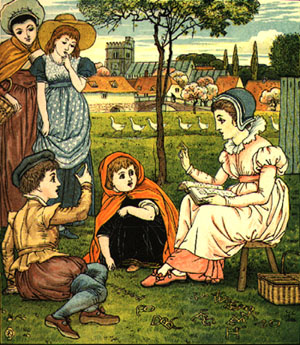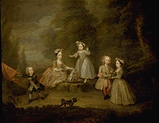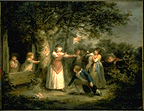

Children's stories of the eighteenth century were primarily didactic in their purpose. On this page, we attempt to illustrate what schools of philosophy influenced the content of such literature, as well as the types of things children's literature tried to teach.

Prior to the seventeenth and eighteenth century, Britons did not think of childhood as a separate stage of development. Instead, they looked at children simply as small adults. Check out the painting on the left that demonstrates such an attitude.
 During the
seventeenth and eighteenth centuries, however, adults began to look
at their children differently. New philosophies such as John Locke's
theorized childhood as distinctly separate from adulthood, and such
ideas proliferated.Take a look at another
painting that illustrates such a
perception. During the eighteenth century in particular, the English
began to perceive children as imprintable individuals who could be
taught morals and conduct. To support this new thinking, authors
began to write literature for children with the intent of teaching
them. The goal of children's literature was didactic.
During the
seventeenth and eighteenth centuries, however, adults began to look
at their children differently. New philosophies such as John Locke's
theorized childhood as distinctly separate from adulthood, and such
ideas proliferated.Take a look at another
painting that illustrates such a
perception. During the eighteenth century in particular, the English
began to perceive children as imprintable individuals who could be
taught morals and conduct. To support this new thinking, authors
began to write literature for children with the intent of teaching
them. The goal of children's literature was didactic.
The eighteenth century was greatly influenced by varying philosophies of the day. Three in particular stand out as influencing adult's perceptions of children.
In this model, children's personalities were controlled by forces beyond human control.
This model held that infant's minds were "blank slates" and that adults could imprint upon them whatever they wished.
This model stressed the inherent goodness of each child. According to such thinking, the child is best educated if allowed personal freedom of growth and thought, independent from the corrupting influence of evil adult institutions.
With more popular philosophies expounding the notion that children could be molded, children's literature became instructional. Three types of instruction were particularly prominent.
Especially in the earlier parts of the eighteenth century, children's literature was devoted to religious pursuit. This emphasis on religious instruction, however, gave credibility to authors later in the century who sought to also stimulate the imaginations of the young with stories of various genres.
Throughout the eighteenth century, the divisions between the classes became more and more blurred as the middle class began to encroach upon the aristocracy. The upper classes retaliated by enforcing class divisions wherever they could. Children's literature of the period assisted such attempts to enforce class differences.
During the eighteenth-century, children's literature reflected and instilled many of the cultural norms concerning gender roles. In particular, the female perception in literature evolved towards more influential agent of social change.
In summary, we offer our own original children's story, the Adventures of Little Tom. We borrow from eighteenth century traditions, trying to incorporate elements we've discussed (as well as others). In addition, we've attempted to follow the basic form of a children's story written in the eighteenth century.
Eighteenth-Century England Home
This
site has been accessed
times since April 30, 2002